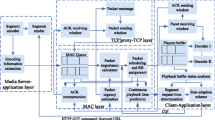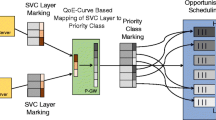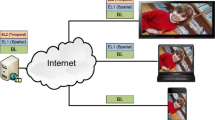Abstract
Channel zapping delay is a big challenge in delivering TV service over the Internet infrastructure. Previous research works have studied this delay, its components, and solutions to decrease it. Unfortunately, the best proposed solutions reduce the delay at the expense of increasing bandwidth usage or decreasing the received video quality. After channel switching, the Set Top Box (STB) or player application should buffer sufficient frames before starting to play the received video. However, the buffering process takes place at the playback rate and leads to a delay which is inversely related to the buffer duration. Regarding Information Centric Networking (ICN) paradigm, this paper introduces a new channel zapping protocol that aims to remove the synchronization and buffering delays while maintaining the bandwidth utilization and also the received video quality. The general idea of the proposed solution is to exploit the in-network caching feature of the ICN to retrieve the frames from the network at the network speed. Although the analyses show that the proposed zapping protocol eliminates the delay dependency to the buffer duration, network throughput becomes the bottleneck instead. So, novel solutions have been proposed to reduce the queuing delay as the main component of network delay. These solutions include two new caching algorithms, a new cache replacement algorithm, and applying scheduling methods to the forwarding queues. Simulation results show that increasing link rates, using the proposed caching and cache replacement algorithms, and applying an appropriate scheduling method will greatly reduce the zapping delay without sacrificing the bandwidth or video quality.



























Similar content being viewed by others
Notes
Leave Copy Down
Betweenness Centrality
Leave Copy Everywhere
Dynamic Video Caching
Least Recently Used
References
Abdullahi I, Arif S, Hassan S (2015) Survey on caching approaches in information centric networking. J Netw Comput Appl 56:48–59
Ahmad MZ, Qadir J, Rehman N, Baig A, and Majeed H (2009) Prediction-based channel zapping latency reduction techniques for IPTV systems—a survey, International conference on, emerging technologies, pp. 466–470.
Amadeo M, Molinaro A, Ruggeri G (2013) E-CHANET: routing, forwarding and transport in information-centric multihop wireless networks. Comput Commun 36:792–803
Ardissono L, Gena C, Torasso, P, Bellifemine F, Difino A, and Negro B (2004)User modeling and recommendation techniques for personalized electronic program guides: Springer
Arumaithurai M, Chen J, Monticelli E, Fu X, and Ramakrishnan KK, (2014), Exploiting ICN for flexible management of software-defined networks, in Proceedings of the 1st international conference on Information-centric networking, pp 107–116
Named Data Networking (11/05/2016) Available: http://www.named-data.net
Begen AC, Glazebrook N, and Steeg WV (2009) A unified approach for repairing packet loss and accelerating channel changes in multicast IPTV. In 6th IEEE consumer communications and networking conference (CCNC), pp 1–6
Bejerano Y and Koppol PV (2009) Improving zap response time for IPTV. in INFOCOM, IEEE, pp. 1971-1979.
CCNx project, http://blogs.parc.com/ccnx/. Accessed October 2016
Cho C, Han I, Jun Y, and Lee H, (2004) Improvement of channel zapping time in IPTV services using the adjacent groups join-leave method. The 6th international conference on, advanced communication technology, pp. 971–975
Ciancaglini V, Piro G, Loti R, Grieco LA, and Liquori L (2013) CCN-TV: a data-centric approach to real-time video services, 27th international conference on, advanced information networking and applications workshops (WAINA), pp. 982–989
CONVERGENCE project, http://www.ict-convergence.eu. Accessed October 2016
Dannewitz C, Kutscher D, Ohlman B, Farrell S, Ahlgren B, Karl H (2013) Network of information (NetInf) - an information-centric networking architecture. Comput Commun 36:721–735
Detti A, Melazzi NB, Salsano S, Pomposini M (2011) CONET: a content centric inter-networking architecture. In: Proceedings of the ACM SIGCOMM workshop on Information-centric networking Toronto. ACM, Ontario, pp. 50–55
Detti A, Ricci B, and Blefari-Melazzi N (2013) Peer-to-peer live adaptive video streaming for Information Centric cellular networks. IEEE 24th international symposium on, personal indoor and mobile radio communications (PIMRC), pp. 3583–3588.
Eftekhari S, Ghahfarokhi BS, and Moghim N (2015) Otanes: a live tv simulator for content-centric networking. 7th conference on, information and knowledge technology (IKT), pp 1–6
Fuchs HF (2008) Optimizing channel change time in IPTV applications. 2008 I.E. international symposium on, broadband multimedia systems and broadcasting, pp 1–8
Han B, Wang X, Choi N, Kwon T, Choi Y (2013) AMVS-NDN: Adaptive mobile video streaming and sharing in wireless named data networking. 2013 I.E. conference on, computer communications workshops (INFOCOM WKSHPS). Turin, pp.:375–380
https://www.gartner.com/doc/3100229/hype-cycle-networking-communications-. Accessed July (2016)
Jacobson V, Smetters DK, Thornton JD, Plass MF, Briggs NH, and Braynard, RL (2009) Networking named content. In: Proceedings of the 5th international conference on Emerging networking experiments and technologies, pp 1–12
Kalman M, Steinbach E, Girod B (2004) Adaptive media playout for low-delay video streaming over error-prone channels. IEEE Trans Circuits Syst Video Technol 14:841–851
Kim Y, Park JK, Choi HJ, Lee S, Park H, Kim J, Lee Z, and Ko K (2008) Reducing IPTV channel zapping time based on viewer’s surfing behavior and preference. IEEE International Symposium on Broadband Multimedia Systems and Broadcasting, pp 1–6
EvalVid - a video quality evaluation tool-set, http://www2.tkn.tu-berlin.de/research/evalvid/fw.html. Accessed October 2016
Kooij RE, Kamal A, and Brunnström K (2006) Perceived quality of channel zapping, in communication systems and networks, pp 156–159
Koponen T, Chawla M, Chun BG, Ermolinskiy A, Kim KH, Shenker S, and Stoica I (2007) A data-oriented (and beyond) network architecture. ACM SIGCOMM computer communication review, pp 181–192
Kyryk M, Pleskanka N, and Sylyuchenko M (2012) Reducing channel zapping time based on predictive tuning method. In proceedings of international conference on modern problem of radio engineering, Telecommunications and Computer Science
Lederer S, Mueller C, Rainer B, Timmerer C, and Hellwagner H (2013) Adaptive streaming over content centric networks in mobile networks using multiple links. 2013 I.E. international conference on communications workshops (ICC), pp 677–681
Lee J, Lee G, Seok S, and Chung B (2007) Advanced scheme to reduce IPTV channel zapping time, in Managing Next Generation Networks and Services: Springer, pp. 235–243.
Lee Y, Lee J, Kim I, Shin H (2008) Reducing IPTV channel switching time using H. 264 scalable video coding. IEEE Trans Consum Electron 54:912–919
Lee CY, Hong CK, Lee KY (2010) Reducing channel zapping time in iptv based on user’s channel selection behaviors. IEEE Trans Broadcast 56:321–330
Lee S, Moon H, Bahn H, Kim T, Kim I-S (2011) Popularity and adjacency based prefetching for efficient IPTV channel navigation. IEEE Trans Consum Electron 57:1135–1140
Li Z and Simon G (2011) Time-shifted TV in content centric networks: the case for cooperative in-network caching. IEEE international conference on, communications (ICC), pp 1–6
Liu Y, Geurts J, Point JC, Lederer S, Rainer B, Muller C, Timmerer C, and Hellwagner H (2013) Dynamic adaptive streaming over CCN: a caching and overhead analysis. IEEE international conference on, communications (ICC), pp. 3629–3633
Mandal SK and MBuru M (2008) Intelligent pre-fetching to reduce channel switching delay in IPTV systems, Dept. of Comp. Sci., Texas A & M University, tech. rep
SAIL Project (11/05/2016) Available: http://www.sail-project.eu
PURSUIT Project (2013, 11/05/2016) Available: http://www.fp7-pursuit.eu/PursuitWeb
Oh U, Lim S, Bahn H (2010) Channel reordering and prefetching schemes for efficient IPTV channel navigation. IEEE Trans Consum Electron 56:483–487
Qiu T, Ge Z, Lee S, Wang J, Xu J, and Zhao Q (2009) Modeling user activities in a large IPTV system. Proceedings of the 9th ACM SIGCOMM conference on internet measurement conference, pp. 430–441.
Rainer B, Posch D, Hellwagner H (2016) Investigating the performance of pull-based dynamic adaptive streaming in NDN. IEEE Journal on Selected Areas in Communications PP(99):1
Ramos FM (2013) Mitigating IPTV zapping delay. IEEE Commun Mag 51:128–133
Ramos FM, Crowcroft J, Gibbens RJ, Rodriguez P, and White IH, (2010) Channel smurfing: minimising channel switching delay in IPTV distribution networks. Multimedia and expo (ICME), IEEE international conference, pp 1327–1332
Ramos F, Crowcroft J, Gibbens RJ, Rodriguez P, White IH (2011) Reducing channel change delay in IPTV by predictive pre-joining of TV channels. Signal Process Image Commun 26:400–412
Siebert P, Van Caenegem TN, Wagner M (2009) Analysis and improvements of zapping times in IPTV systems. IEEE Trans Broadcast 55:407–418
Sun W, Lin K, Guan Y (2008) Performance analysis of a finite duration multichannel delivery method in IPTV. IEEE Trans Broadcast 54:419–429
The Abilene Network (2002) University of Texas System
Tian X, Cheng Y, Shen X (2013) Fast channel zapping with destination-oriented multicast for IP video delivery. IEEE Trans Parallel Distrib Syst 24:327–341
TRIAD.(4/13/2015) Available: http://gregorio.stanford.edu/triad
Xylomenos G, Ververidis C, Siris V, Fotiou N, Tsilopoulos C, Vasilakos X, Katsaros K, Polyzos G (2013) A survey of information-centric networking research. IEEE Commun Surv Tutorials 16:1024–1049
Author information
Authors and Affiliations
Corresponding author
Rights and permissions
About this article
Cite this article
Ghahfarokhi, B.S., Moghim, N. & Eftekhari, S. Reducing channel zapping time in live TV broadcasting over content centric networks. Multimed Tools Appl 76, 23239–23271 (2017). https://doi.org/10.1007/s11042-016-4037-3
Received:
Revised:
Accepted:
Published:
Issue Date:
DOI: https://doi.org/10.1007/s11042-016-4037-3




